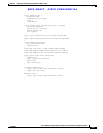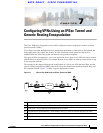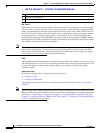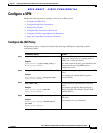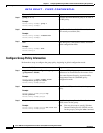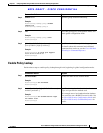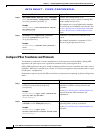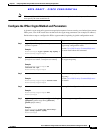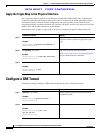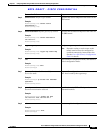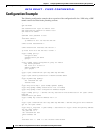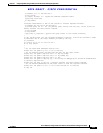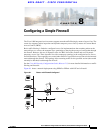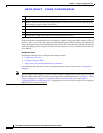
BETA DRAFT - CISCO CONFIDENTIAL
7-7
Cisco 1800 Series Integrated Services Routers (Fixed) Software Configuration Guide
OL-6426-02
Chapter 7 Configuring VPNs Using an IPSec Tunnel and Generic Routing Encapsulation
Configure a VPN
Note With manually established security associations, there is no negotiation with the peer, and both sides
must specify the same transform set.
Configure the IPSec Crypto Method and Parameters
A dynamic crypto map policy processes negotiation requests for new security associations from remote
IPSec peers, even if the router does not know all the crypto map parameters (for example, IP address).
Perform these steps to configure the IPSec crypto method, beginning in global configuration mode:
Command or Action Purpose
Step 1
crypto dynamic-map dynamic-map-name
dynamic-seq-num
Example:
Router(config)# crypto dynamic-map dynmap 1
Router(config-crypto-map)#
Creates a dynamic crypto map entry, and enters
crypto map configuration mode.
See the Cisco IOS Security Command Reference
for more detail about this command.
Step 2
set transform-set transform-set-name
[transform-set-name2...transform-set-name6]
Example:
Router(config-crypto-map)# set
transform-set vpn1
Router(config-crypto-map)#
Specifies which transform sets can be used with
the crypto map entry.
Step 3
reverse-route
Example:
Router(config-crypto-map)# reverse-route
Router(config-crypto-map)#
Creates source proxy information for the crypto
map entry.
See the Cisco IOS Security Command Reference
for details.
Step 4
exit
Example:
Router(config-crypto-map)# exit
Router(config)#
Enters global configuration mode.
Step 5
crypto map map-name seq-num [ipsec-isakmp]
[dynamic dynamic-map-name] [discover]
[profile profile-name]
Example:
Router(config)# crypto map static-map 1
ipsec-isakmp dynamic dynmap
Router(config)#
Creates a crypto map profile.



